Showing top 0 results 0 results found
Showing top 0 results 0 results found

Ever wondered how chatbots, especially the diverse types of chatbots, could save your business an astronomical amount of time? By the end of 2024, it's expected that chatbots will have saved businesses up to 2.5 billion hours of work.
This staggering statistic highlights not just the efficiency of chatbots but their escalating importance in the digital world.
As businesses continue to seek innovative ways to engage customers, understanding the different types of chatbots becomes crucial.
This article dives into the diverse world of artificial intelligence (AI) and conversational AI, offering insights into how these virtual assistants can transform your customer service, sales, and overall operational efficiency.
We'll explore several key areas to give you a comprehensive view of the chatbot ecosystem:
- What are the different types of chatbots?
- Examples of chatbot use cases.
- Benefits of using a chatbot.
- How to choose the best chatbots for your business.
Whether you're new to the concept of chatbots or looking to enhance your existing digital strategy, this article aims to provide valuable insights and practical advice to navigate the vast potential of conversational AI.
Let's dive in to uncover how the right type of chatbot software can revolutionize the way you interact with your customers and streamline your business processes.
What is a chatbot?

A chatbot is a computer program designed to simulate human conversation with users, leveraging various degrees of AI.
While not all chatbots are AI-equipped, modern iterations frequently incorporate conversational AI techniques, such as natural language processing (NLP), to comprehend user inquiries and automate responses, facilitating a more intuitive and efficient interaction.
What are the different types of chatbots?

It's clear that not all chatbots are created equal. Depending on what you're looking for, whether it's something straightforward for answering common questions or a more complex system that learns from conversations, there's a variety out there.
Let's break them down so you can figure out which one might fit your needs.
1. Rule-based chatbots
Consider rules-based chatbots as the reliable, consistent members in the vast family of artificial intelligence chatbots. They're straightforward, sticking to a script based on if-this-then-that logic.
Great for handling the basics like FAQ chatbots or starting off a conversation with a potential lead, these bots guide users through a set process.
Imagine asking a bot about a store's return policy and getting a quick, straight answer—that's them doing their thing.
2. Keyword recognition-based chatbots
Moving up a notch, we encounter AI-powered chatbots that focus on your written words, specifically identifying key phrases or user queries for a more nuanced response. They're a bit like that friend who always catches the important bits of what you're saying.
Say you're chatting about needing to reset your password; these bots will pick up on that and help. It's a step towards more relevant conversations, all thanks to keyword spotting.
3. Menu-based chatbots
Menu-based chatbots are all about keeping things orderly. They lay out choices for you, similar to navigating through a phone's call directory.
It's a straightforward way to funnel your needs into more specific areas, especially handy in scenarios like shopping online where you might start at "Men's Apparel" and end up finding the perfect "Formal Shirt."
4. Contextual chatbots
At this juncture, things become particularly fascinating with artificial intelligence chatbots, especially the contextual variety, that remember previous interactions and customize their replies accordingly. They're all about understanding the finer points of a conversation and getting better over time.
Imagine a banking chatbot that not only helps with transactions but also offers advice based on your spending habits—that's the smart, adaptive nature of these bots.
5. Hybrid chatbots
Hybrid chatbot models represent the best of both worlds, blending the straightforwardness of rule-based bots with the dynamic adaptability of AI-powered chatbots.
They're flexible and able to handle both the straightforward and the complex, making them a good choice for businesses that need both.
Whether it's fielding common queries or offering personalized suggestions, these bots have got it covered.
6. Voice chatbots
Finally, for users preferring vocal communication over typing, voice bots stand ready to transform the user experience. They're leading the charge in making interactions as natural as possible, perfect for when your hands are tied up with other tasks.
From controlling your smart home to catching up on the news without lifting a finger, these bots bring a whole new level of convenience.
Rule-based vs. AI chatbots: what's the difference?
When it comes to chatbots, there are the straightforward, rule-based ones and the smarter, AI-driven types.
Here's the lowdown on how they stack up against each other:
- Learning curve: Rule-based chatbots are like set-it-and-forget-it tools. They don’t learn or adapt from conversations. AI chatbots, on the other hand, are the learners of the bunch, getting smarter with every interaction.
- Flexibility in responses: If you’ve got predictable questions, rule-based chatbots are your go-to. Need something that can handle a curveball? AI chatbots can manage a wider range of queries thanks to their knack for understanding and processing user inputs.
- Conversational flow: Engaging with rule-based bots might occasionally give the impression of a one-sided human interaction. AI chatbots aim for a more natural vibe, making conversations flow more like they would with a human.
- Handling complexity: Simple Q&A? A rule-based chatbot can handle that in its sleep. But if you’re dealing with more complex questions or need a chatbot to think on its feet, AI is where it’s at.
- Integration smarts: Rule-based chatbots work well with a limited set of tools, but AI chatbots take it to another level by being able to integrate with a broad spectrum of systems and databases.
- Scalability: Need to scale or tweak your chatbot? Rule-based ones require a manual touch, while AI chatbots learn and adapt on the fly, making them more flexible for growing needs.
- User experience: Expect consistency from rule-based chatbots, but if you’re looking for a personalized touch based on past interactions, AI chatbots are your friend.
- Upkeep: Keeping a rule-based chatbot up to date can be a chore, requiring regular manual updates. AI chatbots, though, learn as they go, reducing the heavy lifting on maintenance.
Deciding between the two really boils down to what you need your chatbot to do, how complex your interactions are, and how much you're looking to automate the conversation.
Chatbot use cases across industries
Chatbots aren't just a one-industry wonder; they're making AI technology waves across the board.
Here’s how they’re playing out in different sectors:
Ecommerce
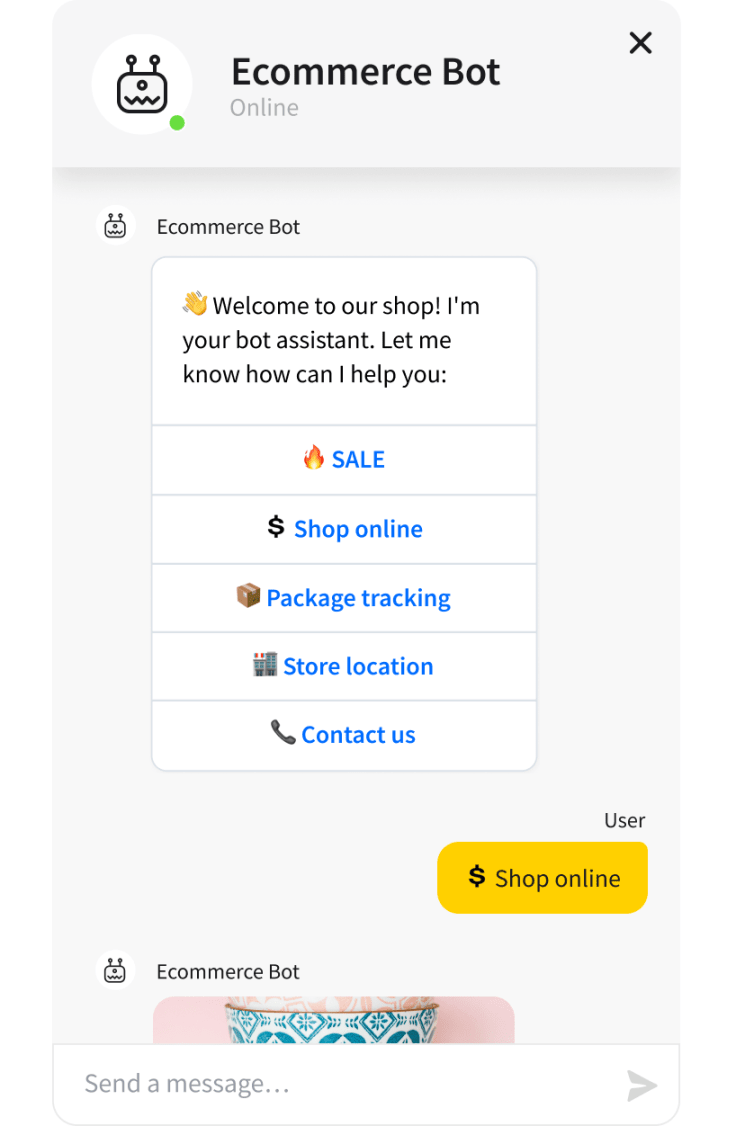
Imagine a chatbot as your go-to shopping buddy online, there whenever you need it. These bots get to know your tastes and preferences, suggest products you'll love, help with any questions, and keep tabs on your orders.
It’s like having a personal shopper on standby, boosting your shopping experience and keeping you coming back.
If you need an ecommerce chatbot, our tool offers this kind of top-notch, personalized service round the clock without the need for a human team on call 24/7.
Start a free 14-day trial to see what our ChatBot can do.
Banking and finance
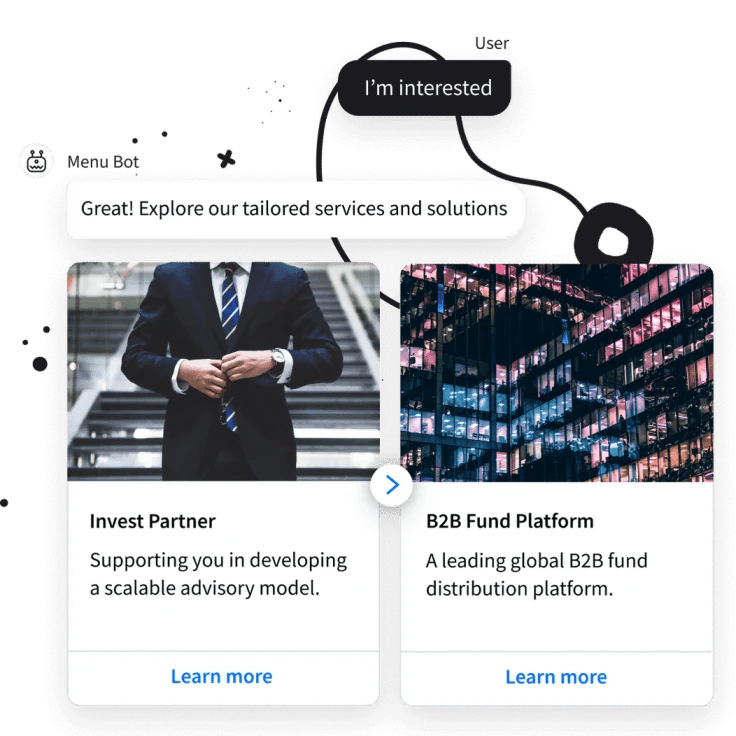
Finance chatbots can act as your financial guide, ready to assist with balance inquiries or provide advice without the need for a branch visit. They streamline banking operations, making it easier to manage your finances from anywhere, at any time.
The technology behind these services equips financial institutions with the tools to deploy sophisticated bots, automating routine inquiries and transactions, thereby allocating more time to cater to complex customer needs.
Healthcare
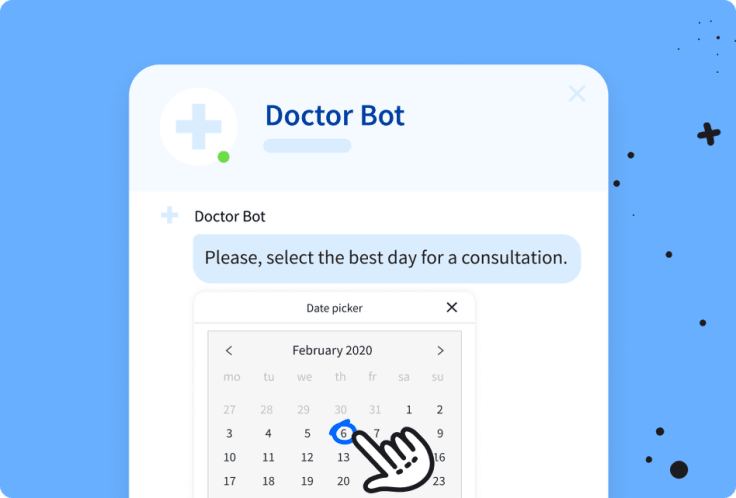
Chatbots for healthcare are here to change the game. They offer a way to check symptoms, book appointments, and access health info straight from your chat app. They’re your on-demand health advisor, making healthcare more accessible and engaging.
With ChatBot, providers can set up secure bots to handle patient queries efficiently, ensuring personal health data is in good hands and operations run smoothly.
Start a free 14-day trial to see what our ChatBot can do.
Education
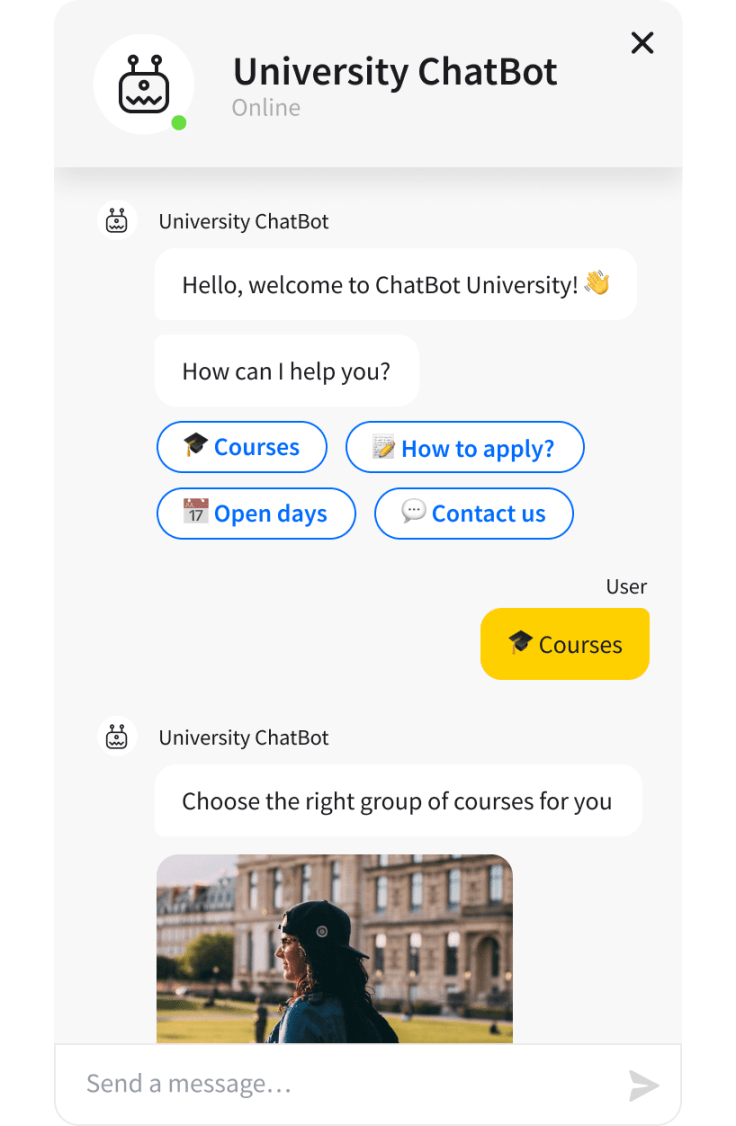
In education, chatbots are the ultimate study partners, ready to assist 24/7 with everything from admin stuff to academic support. They make learning resources and help more accessible and tailor support to individual needs.
Chatbot for education helps educational institutions create these helpful bots, giving students instant access to the support and info they need whenever they need it.
Travel and hospitality
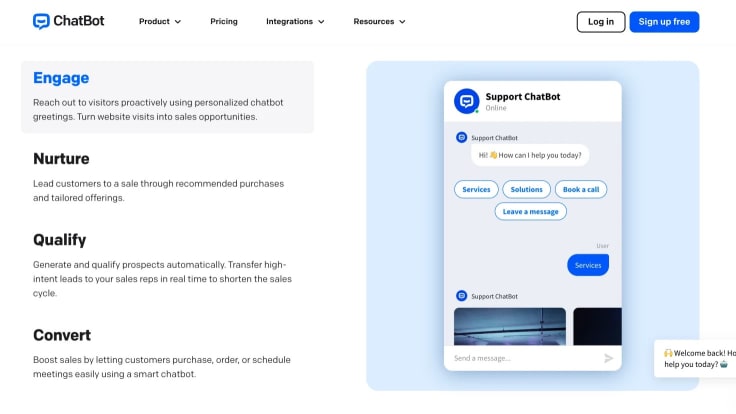
For travel and hospitality, think of chatbots as your digital concierge. They are there to help with bookings, share local tips, and manage guest services. They make planning travel and stays a breeze, offering personalized service at your fingertips.
Travel chatbots make it possible for businesses to offer instant, customized assistance, changing how they connect with customers.
Real estate

Real estate chatbots are reshaping interactions between agents and clients, helping qualify leads, providing property details, and setting up viewings. They streamline the start of the customer journey, ensuring potential buyers get the info they need right away.
Our tool enables real estate businesses to build bots that make the buying process more efficient and responsive for everyone involved.
Insurance
Navigating insurance policies and claims gets a whole lot easier with chatbots. They offer instant answers and guide you through the claims process, demystifying insurance and boosting satisfaction.
An insurance chatbot lets insurance companies deploy bots that respond swiftly and accurately to customer queries, streamlining policy management and claims processing.
Start a free 14-day trial to see what our ChatBot can do.
Retail

Retail chatbots transform customer service by offering product recommendations, handling returns and exchanges, and answering questions about product availability and specifications. They create a more interactive shopping experience, driving customer loyalty and repeat business.
ChatBot’s retail templates allow businesses to quickly deploy chatbots that cater to their customer's specific needs, making shopping as seamless as possible.
Restaurants

For restaurants, chatbots take care of reservations, manage orders, and answer common questions, smoothing out operations and enhancing the dining experience. They provide the convenience of instant service, whether you’re booking a spot or ordering takeout.
A restaurant chatbot helps you implement these contextual chatbot solutions effortlessly, boosting customer service and operational efficiency with adaptable chatbot features.
Benefits of using a chatbot
Chatbots and virtual assistants are changing the game in customer service, and they’re here to make things easier for everyone involved. Let’s dive into the perks of having one of these digital helpers around.
Quicker responses
Nobody likes waiting around, especially when they have a question or an issue that needs sorting. That’s where chatbots come into play. They’re always ready to jump in—day or night—making sure customers get the answers they need without any frustrating delays.
It turns out a lot of folks (about 40% of internet users) are even starting to prefer these quick-chatting bots over traditional human customer service. It's fundamentally about achieving immediate satisfaction through efficient customer support chatbots and proceeding with your activities.
Engagement levels go up
Chatbots have a knack for turning casual website visitors into active participants. They’re like friendly store greeters who not only say hello but also offer help finding what you need.
By starting conversations and keeping them going, chatbots help collect useful info, juggle several chats at once, and guide people through becoming interested leads. It’s a more dynamic, personalized way to have sales chatbots that feel tailored to each visitor.
Your brand looks better
Fast replies don’t just solve problems; they also make your brand look good. With 76% of the younger crowd judging a brand’s coolness by how quickly it responds to customer feedback, being slow can make you look bad. Chatbots keep your brand in the fast lane, showing that you’re all about customer care, which can seriously boost how people see you.
Getting the inside scoop
Chatbots do more than answer questions; they’re also great at gathering insights. Every chat helps you learn more about what your customers like, what they’re asking about, and how you can serve them better.
This data goldmine helps tailor your products or services to fit your customers' preferences and needs like a glove, making each interaction count towards a better experience.
Smoothing out operations
Adding a chatbot to the mix can really streamline work. By handling the routine stuff, chatbots free up your human team to focus on the trickier, more nuanced tasks.
It’s about working smarter, not harder, allowing your team to concentrate on what humans do best—like empathy and creativity—while the bot covers the basics.
Plus, chatbots can scale up as your business grows, keeping things running smoothly without a big jump in costs.
Always there when you need them
One of the best things about chatbots is their tireless work ethic. They’re on call 24/7, ready to help out whenever and wherever it’s needed.
This round-the-clock support means your customers never have to wait until "opening hours" to get help, making your brand a go-to source of reliable assistance no matter the hour. It’s a win-win for customer satisfaction and your brand’s reputation.
How to choose the best chatbot for your business
Choosing the right chatbot for your business is more than a technical decision—it's about finding a digital ally that fits seamlessly into your operations and grows along with you.
Here’s a straightforward guide to picking a chatbot that clicks with your business needs:
- Know your why: Start by pinpointing exactly why you want a chatbot. Is it for boosting sales, streamlining customer service, or a bit of both? Make sure the chatbot you pick is up for the job.
- Easy does it on integration: Aim for a chatbot that plays nice with your current systems. You want something that slips into your setup without causing a fuss.
- Smart and gets smarter: Look for a chatbot armed with the brains—AI and machine learning—so it learns and evolves from every interaction, getting better at helping your customers.
- Understands like a human: Choose a chatbot that knows the nuances of human conversation. A strong grip on NLP means it can chat more naturally and accurately with your customers.
- Speaks their language: If your business crosses borders, a chatbot that can converse in multiple languages is a must to make sure all your customers feel at home.
- Customizable character: It’s important that your chatbot can mirror your brand’s tone and style. Flexibility in customization means your chatbot feels like part of your team.
- Ready to grow: Ensure your chatbot can scale up smoothly as your business expands, handling more chats without breaking a sweat.
- Safety first: Security is non-negotiable. Your chatbot should be a vault, meeting the highest data protection standards and keeping your customers’ info safe.
- Insights and analytics: A chatbot with analytics can give you a clear picture of customer needs and how well you’re meeting them, offering chances to fine-tune your approach.
- Budget-friendly: Make sure the costs align with your budget. Consider all the expenses—initial setup, maintenance, and any ongoing fees—and weigh them against the expected benefits.
- Support you can count on: Go with a provider known for stellar support and reliability. It’s comforting to know you have expert help whenever you need it.
- Customer-friendly design: Your customers should find the chatbot easy and pleasant to use. A good user experience boosts their satisfaction and your reputation.
- Try before you buy: If there’s a chance to test drive the chatbot, take it. It’s the best way to see if it fits with your operations and meets your customers’ expectations.
With these pointers, you’ll be in a great position to choose a chatbot that’s not just a tool but a true extension of your customer service team, ready to grow with your business.
How to build an AI chatbot with ChatBot
Building an AI chatbot with ChatBot simplifies the process of enhancing your customer engagement without the need for advanced coding skills. Here's a streamlined guide to creating, testing, and deploying your chatbot.
Setting up your chatbot
Start your project: Begin by signing up for a free ChatBot trial. Once your account is activated, head to the dashboard and click on "Add chatbot" to kickstart your project.
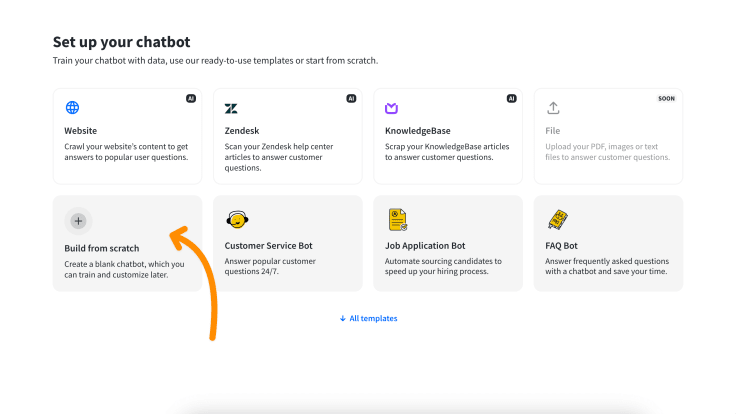
Choose your build method: You have the flexibility to build your bot from scratch, use AI Assist to scan your website for FAQ automation, or select from a variety of templates tailored to different business needs.
Customize your conversation flow: Navigate to the Visual Builder to find a basic conversation structure. Here, you can customize the welcome message, add text responses, images, quick replies, and more to design a conversational flow that aligns with your objectives.
Testing your chatbot
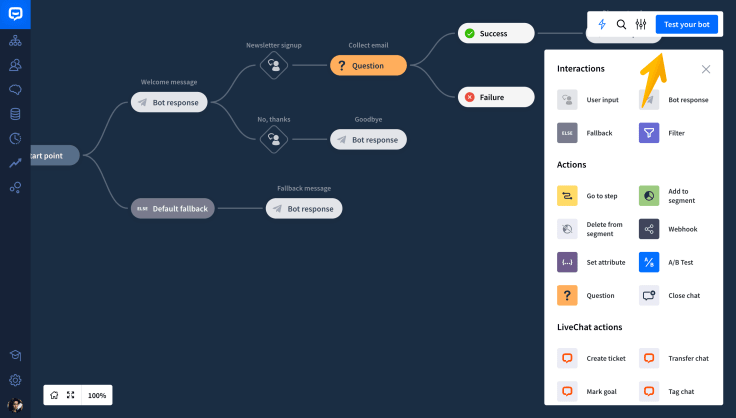
Test in the visual builder: Use the built-in testing tool in the Visual Builder to interact with your chatbot. This allows you to identify and fix any issues in real time, ensuring your bot functions as intended.
Reset and retest: If you want to explore different conversation paths, you can reset the chat within the testing tool to thoroughly test each aspect of your chatbot's responses and functionalities.
Deploying your chatbot
Publish your bot: Once satisfied with the testing, click "Publish" to save all the changes and get your chatbot ready for deployment.
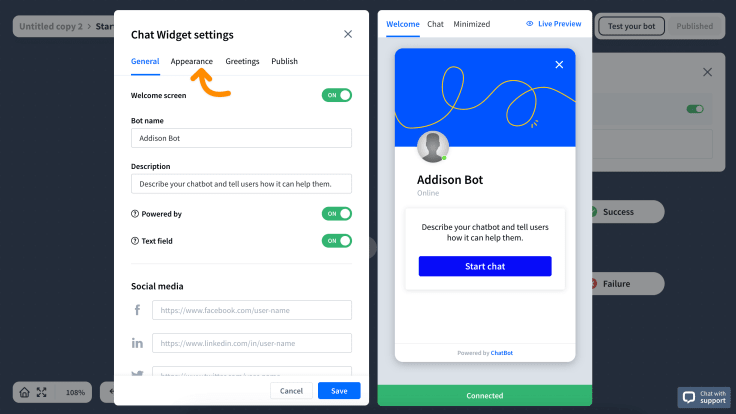
Integrate with your website: Go to the "Integrations" section and select "Chat Widget." Customize the widget to match your brand's aesthetics, then copy the provided chatbot code.
Embed on your website: Paste the copied code into your website's HTML before the closing </body> tag. Refresh your website, and the chat widget will appear, ready to engage with your visitors.
ChatBot streamlines the entire process, from creation to deployment, allowing you to effectively leverage AI chatbots' power. With this approach, your business can offer 24/7 customer support, gather insights, and enhance user engagement without the complexity traditionally associated with chatbot development.
Conclusion
And there you have it—a whirlwind tour through the versatile world of chatbots.
Whether you're just dipping your toes into digital waters or you're ready to dive deep into conversational AI, understanding the different types of chatbots and their capabilities is key to unlocking a whole new level of customer engagement and operational efficiency.
From the straightforward, rule-following bots that keep things ticking over to the AI-powered geniuses that learn and adapt, there's a chatbot out there for every business need.
And with tools like ChatBot, creating and deploying these digital helpers is easier than ever—no coding wizardry required.
Remember, the right chatbot can transform your customer service game and provide insights into your customers' needs, streamline your operations, and ensure your brand is always there when your customers need it, day or night.
So, take the leap, choose wisely, and watch as a chatbot becomes an invaluable member of your team, ready to grow with your business. Let's embrace the future of communication, one chat at a time.
Start a free 14-day trial to see what our ChatBot can do.



